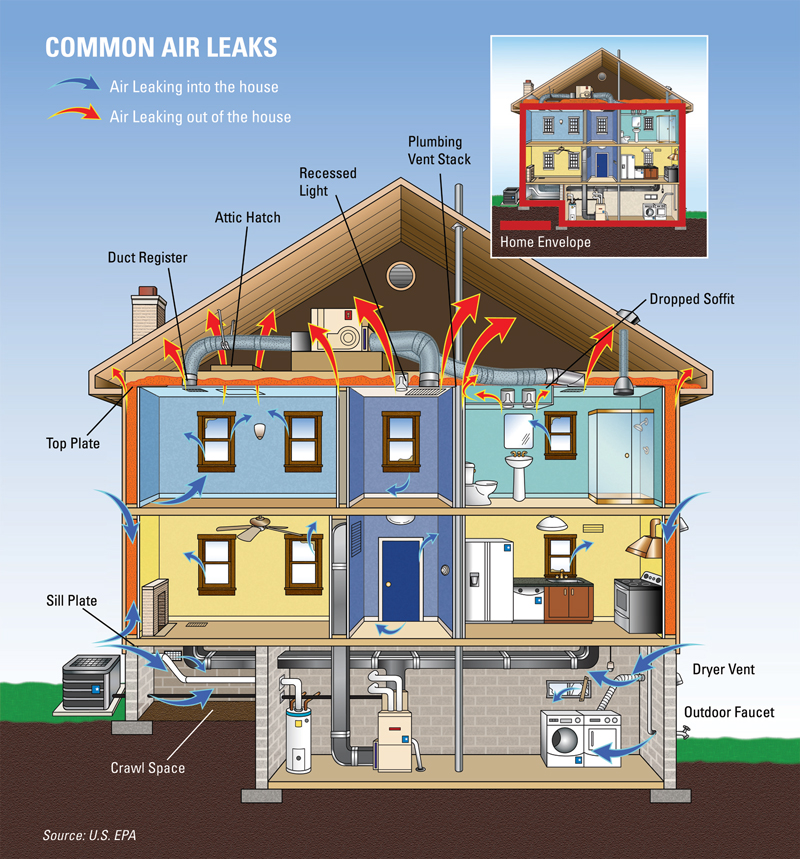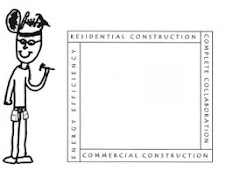As we enter the winter season and temperatures continue to drop we stay indoors more often and use our homes and offices to keep ourselves warm. This can be a simple and easy act of coming inside to a warm home where you can be comfortable all throughout or it can be stressful because your home is cold and turning up the heat still doesnt help, it just costs more and more. It doesnt have to be stressful. You can be comfortable in your home. You DESERVE to be comfortable in YOUR HOME.
"EPA estimates that homeowners can typically save up to 20% of heating and cooling costs (or up to 10% of total energy costs) by air sealing their homes and adding insulation in attics, floors over crawl spaces, and accessible basement rim joists."
Up to 20% savings!!! Take a look at your utility bill...how much are you spending each month?...each year?...Wouldn't you like to reduce that number by up to 20%? Who wouldnt? The solution is simple. Efficiency. If your house is leaky then it isnt working efficiently and you are wasting money. Thats it. Its as simple as that. All of the air leaks are costing you money, its a cycle, as the heated air in your house goes out through leaks in the ceiling, around windows and doors, can lights that arent air tight, electrical outlets, and others cold air is coming in and your HVAC system has to turn on or be turned up to warm the air back up then that air could be leaking out before it even gets to your bedroom if the ducts that it is traveling through aren't sealed properly, that air is wasted into your attic or crawlspace. Then your heating system has to continue to run to keep up with the loss and the longer it works the more money you are spending. Don't waste any more money!
Air sealing and insulation are the best ways to make a difference in your home as far as comfort and energy savings. How do i find the air leaks? Simple, when your heating system is on feel around the perimeter of the house, the ceiling and the floors for cold air coming in. Also, cobwebs are a typical sign of an air leak because spiders like moving air to make their webs. Dirty ceilings around duct registers, recessed can lights, and ceiling fans or lights are also signs of air leaks where the air moving in from the attic is carrying dust that is deposited on the ceiling. Windows and doors are the big offenders. If the weatherstripping around your exterior doors is more that 5 years old or it is compressed so much that you see light from around the door, it is time to replace the weatherstripping. Windows that you can feel a draft need weatherstripping under the sash and caulking around the frame and trim.

Insulation is very important in keeping your house comfortable. I is common to put a coat on to go outside when the weather is cold, the coat is acting as insulation for the heat that your body produces. The thicker the coat the warmer you are. Unless you have a hole in the coat or leave it unzipped. Then the warmth of your body escapes and you feel cold. The same principle applies to your house. The insulation in your attic and walls keeps the inside of your house warm from the heat that your heater produces. If you dont have enough insulation then the heat will transfer trough easier. If you want to know the science behind insulation and the R-Values
HERE it is. But for those that need it a little simpler, the lower the R-value the quicker heat can pass through it. In most situation, the greater the R-value the better the insulative properties.
Most older homes today either have blown in cellulose or fiberglass batt insulation, but most homes dont have enough. Most homes in the southeast are
recommended to have insulation to meet an R value of 38. Thats 12" of fiberglass batts or 11" of blown cellulose. If you dont have that much then you need more, also if your blown in insulation is packed down after being stepped on or boxes placed on it for years then it isnt performing at the level it should be. It needs to be fluffed to be insulating properly or simply add more on top to reach the recommended levels. Typically if you see your ceiling joists when you look in your attic, you need more insulation.
When air sealing your home yourself you need to be cautious of noxious gases such as carbon monoxide that your combustion appliances may produce. If they arent sealed combustion units then they need additional venting to the outside. This provides fresh air for combustion and vents the harmful fumes out to a safe area. Contact a professional if you are unsure about doing this yourself.
So how efficient is your home? How much money are you wasting a month? How much could you be saving? What steps could you take to make a difference in your home? These questions could be answered by a Home Performance Assessment. A Home Performance Assessment is performed by a professional such as Outside The Box Construction and provides a comprehensive report on the performance of your home. Check out our website for more details about a
Home Performance Assessment. Also the
Energy Star Website has more information on what to expect. The Assessment typically takes about a day and produces a prioritized list of improvements that would help your home perform better and save energy and money.
Contact us today if you have any questions. We are more than happy to answer your questions and possibly schedule a HPA for your home.
Outside The Box Construction, LLC.
Project Manager
Scott Mason - 770-547-1527
scott.outsidethebox@gmail.com
Owner
Don Liotta - 404-993-8187
donliotta@gmail.com
www.outsidetheboxconstruction.com

 air that comes from your heater or air conditioner can leak out of the ducts, also air from the uninsulated spaces in your home can bring pollutants into your home. Dust mites, mold, radon, and carbon monoxide are just a few of the things that could be in your duct work and in the air you breathe. So do you know how clean your air is? Outside the Box Construction can be your Indoor Air Quality specialists. We are trained to test and clean your duct work. We can seal and insulate your ducts and make your existing system work better. You owe it to yourself and to your family to keep up with your air quality in your house because its your health and your home.
air that comes from your heater or air conditioner can leak out of the ducts, also air from the uninsulated spaces in your home can bring pollutants into your home. Dust mites, mold, radon, and carbon monoxide are just a few of the things that could be in your duct work and in the air you breathe. So do you know how clean your air is? Outside the Box Construction can be your Indoor Air Quality specialists. We are trained to test and clean your duct work. We can seal and insulate your ducts and make your existing system work better. You owe it to yourself and to your family to keep up with your air quality in your house because its your health and your home.










